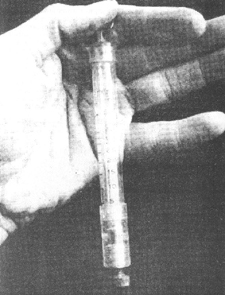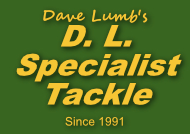[7]
CLOTHING AND OTHER EQUIPMENT
Some of the tackle in this section might
be classed as luxuries by many anglers,
as they are not essential to successful
lure fishing. However they are so useful
that I can't imagine how I would manage
without them. The two that I never leave
home without are my polarising glasses
and peaked cap, even in winter these are
invaluable. So much so that I feel completely
wrong without them.
It
is worth spending as much as you can afford
on your shades as the better quality lenses
will result in improved subsurface vision
and far less eye strain through distortion.
They should also offer far greater U.V.
protection. Choose a pair that has as
large a lens as possible, and maybe even
side panels to cut out even more glare.
Some manufacturers offer a choice of lenses
giving different amounts of light transmission.
A high transmission pair is excellent
for dawn, dusk and dull days, while darker
lenses are at their best in the midday
sun. Having a pair of each is the ideal
situation, but an alternative is to purchase
a pair with yellow lenses which will give
you a compromise. It has to be said that
yellow lenses make everything look brighter
while you are wearing them, but as soon
as you take them off the world takes on
a whole new colour scheme!
Peaked
caps come in all shapes and sizes. Go
for one that is comfortable and keeps
out as much overhead light as possible
in order to prevent glare from the inside
of your sunglasses. An alternative for
summer-wear is a visor, the type that
match anglers and golfers favour. Whether
you choose a cap or a visor, wide peaks
are best of all, but an overlong peak
can actually restrict your forward vision.
In winter pull a woolly hat over the top
of your summer cap, or buy a peaked trapper's
hat with the fold down earflaps. Even
in summer it is worth carrying the old
bob hat as it can be pretty chilly before
and after the sun is high in the sky.
A
pair of fingerless neoprene gloves are
almost as essential as my cap these days.
All year round I find them useful. Being
fingerless they allow me to control my
reel as if I wasn't wearing them, and
being neoprene they keep my hands warm
even when wet. In summer I frequently
just wear one, on my right hand, early
and late in the day when the air temperature
is low. Using a multiplier you always
get water spraying from the spool which
soon cools your hand down. Not so when
you have a neoprene mitten on. For really
cold weather I have considered a pair
of full fingered neoprene gloves, but
with the thumb cut away on the right hand
to facilitate reel control. General clothing
for lure fishing is as you would wear
for any other form of piking, depending
on the weather, but very much with freedom
of movement and mobility in mind. Baggy
jackets are a no-no as they are sure to
catch on the rod butt as you are casting
or working lures. One item worth considering
is a fly-fisher's type waistcoat. These
many pocketed garments come in really
handy for carrying small pieces of kit,
thereby cutting down on the number of
boxes and bags you need to lug around.
A waistcoat that is also a self inflating
life jacket is probably the wisest choice
of all, particularly if you do a lot of
boat fishing or deep wading. For short
evening sessions in high summer all that
is needed is your waistcoat over a T-shirt,
and your usual fishing pants - shorts
if you like getting stung and bitten by
nettles and insects! Carry Jungle Formula
insect repellent and, maybe some sting-relief
in the waistcoat.
Bearing
in mind the vagaries of the British weather
I recommend a good lightweight, waterproof
oversuit for general use. Either one or
two piece, and breathable if you can afford
it. It is best not to go for a lined suit
as these will be too warm in summer. In
winter you can always add extra layers
underneath an unlined suit. For dry spring
and autumn days a quilted one piece suit
is ideal, and even in summer it can come
in useful when out afloat on a large windswept
lake.
Footwear
is always a problem, and there is no easy
solution. Wellies, waders (chest and thigh)
and moon boots all have their place, and
for all their drawbacks thigh waders are
about the best all round choice in summer.
Waders allow you to paddle out in the
margins, and to kneel down in (and walk
through) damp grass, plus they help keep
your legs dry in showers - a jacket keeping
the top half dry. Chest waders have their
uses, and can be used to help catch extra
fish at times. However they are not recommended
where a lot of walking is involved, being
uncomfortable and sweat inducing. If boat
fishing then walking boots or moon boots
are the choice, weather being the deciding
factor.
For
the roving lure angler walking the banks,
one of the biggest problems is how to
carry his lures - particularly the large
ones. Small lures can be easily transported
in any one of a number of box types from
the cantilever to the satchel type, both
available with carrying handles and one
or two with shoulder straps. Even the
plain old Tupperware type box can be used
if only a handful are required for a short
session, or if taking some on a bait fishing
trip. With lures that have smallish treble
hooks, smaller than a 1/0, you have the
option of using hook guards. These plastic
devices are really useful at preventing
lures tangling up in the compartments
of your lure boxes. They also allow you
to carry a few lures in the pockets of
your jacket or waistcoat.

Plano 7910 hanging box, plug pipe, double
sided Plano box and a simple Tupperware
type box. Each one has its place for
lure transportation and storage.
Large
lures are far more troublesome and depending
on how many big baits I think I will need,
I use one of two transportation methods
most of the time. If I am embarking on
a short session of maybe a couple of hours,
then I load up a plug pipe (alternatively
known as a lure tube). Mine can carry
up to twenty lures at a pinch which is
more than enough on a local water where
I have a good idea what is a likely to
work. Watch how you put them in the car
as they have a nasty habit of tipping
over as you go round corners, strewing
lures across the boot! For longer sessions,
and when I feel the need to take the kitchen
sink too, I might pick up a Plano 7910
hanging box which will hold sixty to ninety
large baits. Very useful for boat fishing.
A shoulder bag or small rucksack will
carry camera, scales, food, drinks and
waterproofs. The 7910 boxes are not foolproof
as lures will still tangle. They are good
for storing plenty of large lures in at
home though. Other boxes are available
that work on the same principle as a plug
pipe with individual tubes for each lure,
or you can fill a shoulder bag with tubes
and make yourself an easily transported,
lightweight lure carrier. It is possible
to remove some of the partitions from
a 7910 box, opening up free space for
the camera etc. This reduces its lure
capacity, but means you have less to carry.
An alternative that I use at times is
a jumbo sized (so-called) carp-carryall
into which I can fit my plug pipe, camera,
waterproofs and food and drinks. Although
not the easiest thing to carry I have
everything in one bag for a half day session
tramping the banks. For longer sessions,
especially where long walks are involved
I resort to a rucksack for all my gear
and clothing, carrying a double sided
Plano with the bulk of my required lures
in it. Extra lures can go in a smaller
box in the rucksack. Rods and landing
net are strapped together with Velcro
bands for long walks. When boat fishing
the rucksack is replaced by a matchman's
plastic seat box. They don't look hip,
but they are waterproof and robust - essential
in a boat. Having tried many types of
bag I can assure you that only a seat
box will keep everything dry in a downpour.
When
bait fishing for pike it is easy to determine
the depth of water in front of you by
plumbing with a float. If you are lure
fishing from a boat you might well have
a fish finder or depth sounder on board
to make life even easier. When tramping
the banks, though, neither of these options
is open to you. My solution is a simple
little device that is just clipped to
the trace and cast out. When it has hit
the bottom just wind in and read the depth
off the scale. This handy piece of kit
is called a Depthometer, and although
it looks like a gimmick is actually quite
accurate - certainly accurate enough to
help you with your lure selection.

The Depthometer partialy fills with
water as it sinks, the level being
read off the scale giving a surprisingly
accurate depth reading.



